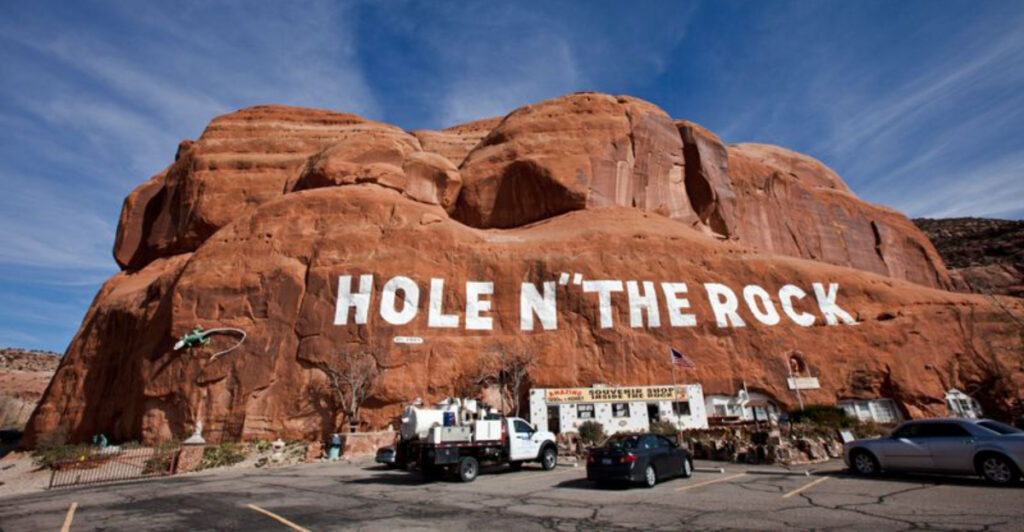Road trips across America offer more than just destinations – they reveal bizarre, wonderful surprises along the way. These quirky roadside attractions transform ordinary journeys into unforgettable adventures. From towering statues to peculiar museums, these unexpected stops create the perfect excuse to stretch your legs and snap some truly unique photos.
1. Lucy the Elephant: New Jersey’s Six-Story Pachyderm
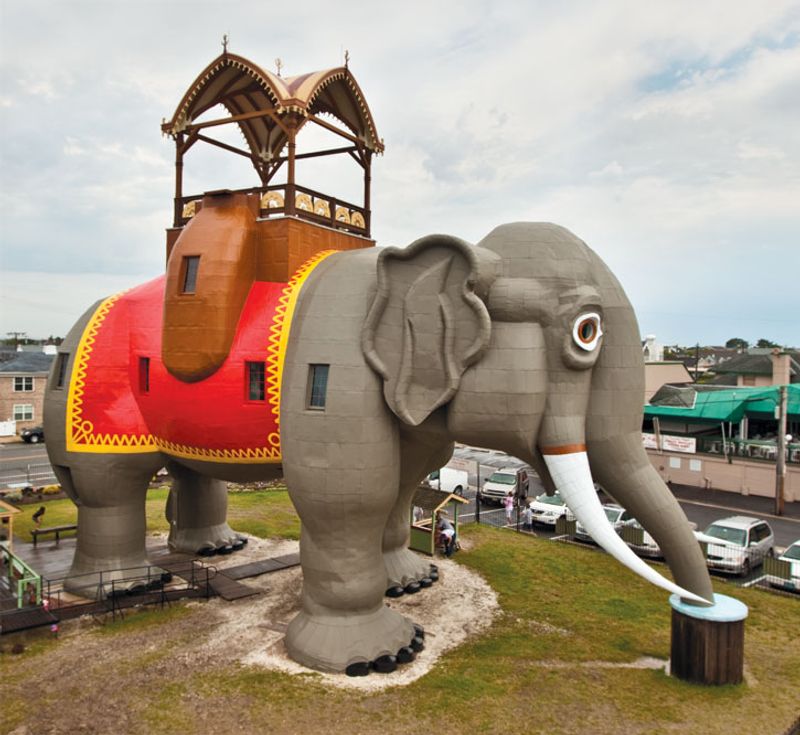
Standing proudly on the Jersey Shore since 1881, this wooden behemoth predates even the Statue of Liberty as an American landmark. Originally built as a real estate gimmick, Lucy has survived Atlantic hurricanes, lightning strikes, and even relocation attempts.
Visitors can climb the spiral staircase inside one leg to reach rooms within her belly, including a gift shop and museum. From her howdah (the carriage on her back), you’ll enjoy panoramic ocean views.
This 65-foot-tall National Historic Landmark remains America’s oldest surviving roadside attraction and the world’s largest elephant sculpture – a testament to Victorian-era architectural whimsy.
2. Cadillac Ranch: Graffiti-Covered Car Art in Texas
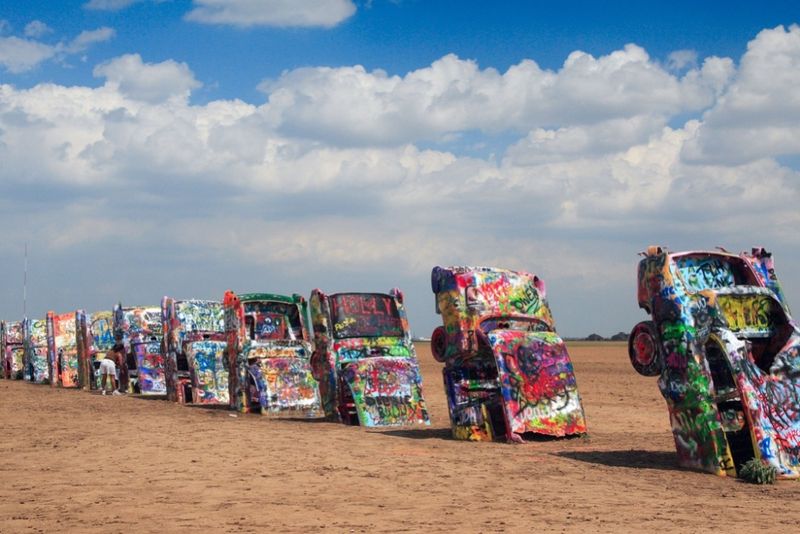
Rising from the flat Panhandle landscape like technicolor dinosaur skeletons, ten vintage Cadillacs stand buried nose-first at identical angles. Created in 1974 by an art collective called Ant Farm, this installation celebrates America’s evolving automotive design from 1949 to 1963.
Unlike most art exhibits, visitors aren’t just allowed but encouraged to add their own spray-painted contributions. The constantly changing canvas of colors creates a surreal, psychedelic monument visible from Interstate 40.
Bring your own spray paint and leave your temporary mark on this ever-evolving piece of Americana – tomorrow’s visitors will paint over it, continuing the cycle of creative destruction.
3. World’s Largest Ball of Twine: Kansas’ Growing Giant
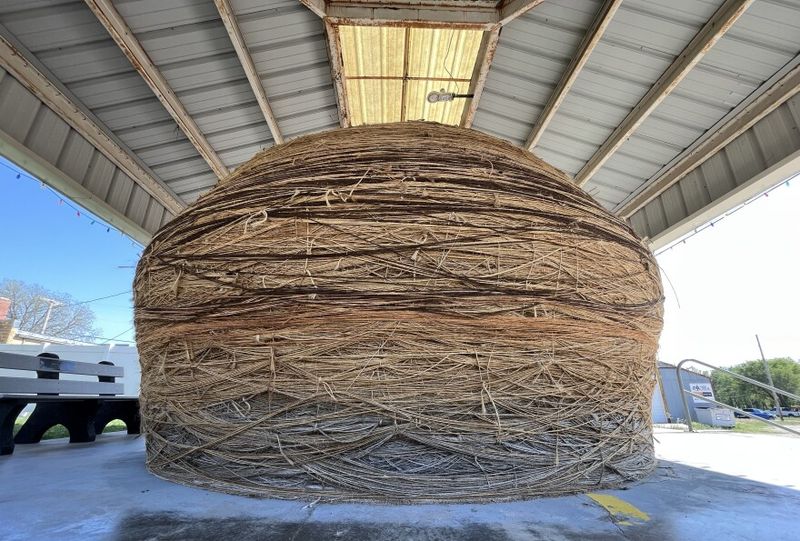
What began in 1953 as farmer Frank Stoeber’s practical solution for leftover twine has morphed into a record-breaking monument to midwestern determination. The massive sphere now weighs over 20,000 pounds and measures more than 40 feet in circumference!
Each August, Cawker City hosts the “Twine-a-Thon” where visitors add more twine to this ever-expanding attraction. A pavilion protects the ball from the elements, while a guest register documents visitors from around the globe.
The town embraces its quirky claim to fame with twine-themed souvenirs and even a song about their beloved ball. It’s the ultimate symbol of small-town America turning something ordinary into extraordinary.
4. Salvation Mountain: California’s Painted Desert Masterpiece
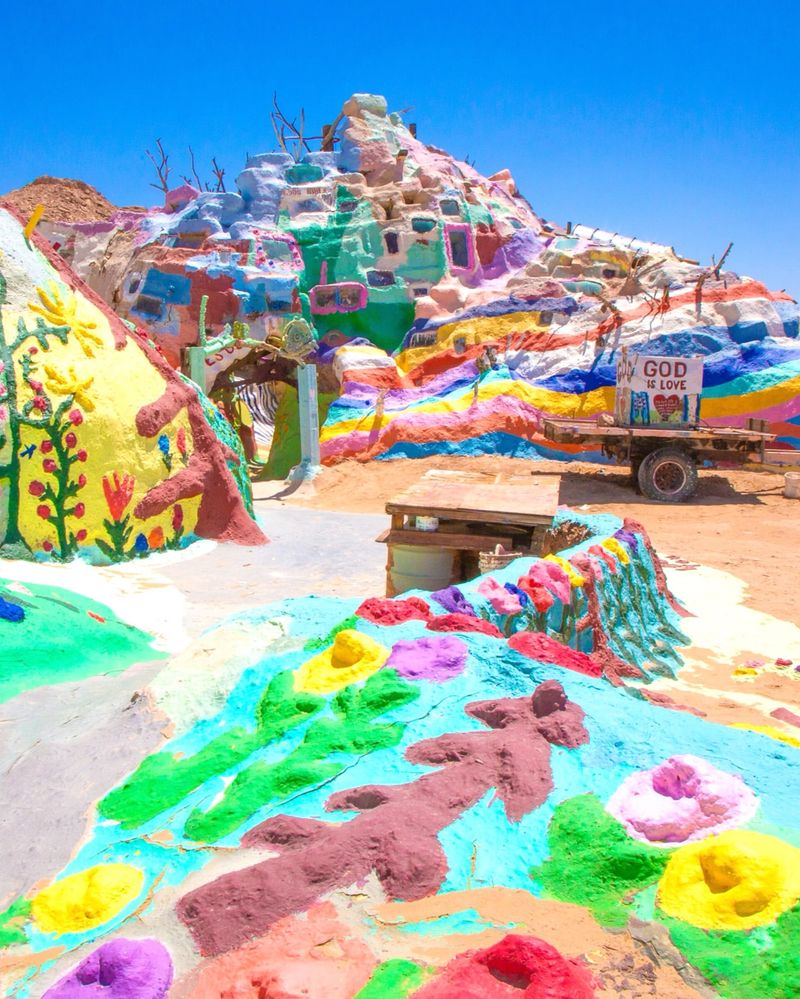
Rising from the California desert like a mirage, this vibrant 50-foot hill covered in half a million gallons of paint proclaims “God Is Love” in bold letters. Leonard Knight spent three decades creating this folk art phenomenon using adobe clay, hay bales, and donated paint.
The mountain features a labyrinth of biblical verses, flowers, waterfalls, and chambers visitors can explore. Located near Slab City (an off-grid community of nomads and artists), it stands as a testament to one man’s unwavering faith and artistic vision.
Despite the harsh desert conditions, volunteers continue maintaining Knight’s legacy after his 2014 passing. This psychedelic religious monument appears in numerous films and music videos, drawing pilgrims of all faiths to its kaleidoscopic slopes.
5. Foamhenge: Virginia’s Styrofoam Stonehenge Replica
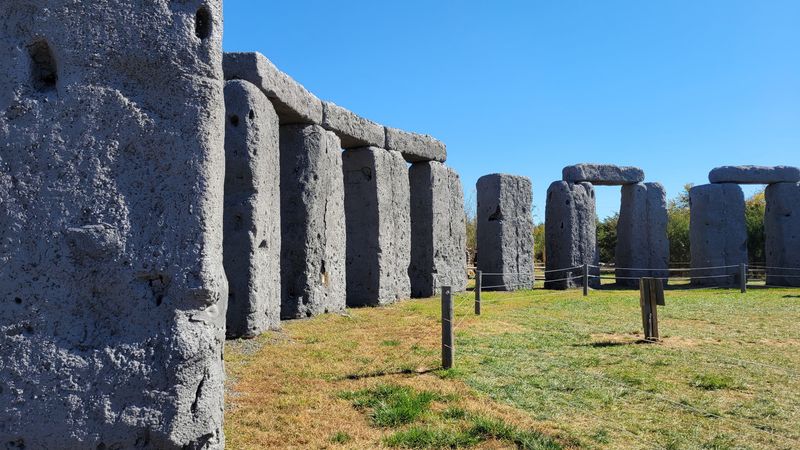
Hidden in the Blue Ridge Mountains stands an uncanny full-scale replica of England’s ancient monument – crafted entirely from styrofoam! Artist Mark Cline unveiled this playful installation on April Fool’s Day 2004, creating an instant roadside sensation.
Each 16-foot foam “stone” weighs just a fraction of its multi-ton inspiration yet mimics the original’s astronomical alignment. Informational plaques explain Stonehenge theories with Cline’s trademark humor sprinkled throughout.
Originally located in Natural Bridge, Foamhenge relocated to Cox Farms in Centreville in 2017 when its original site became a state park. Unlike its 5,000-year-old counterpart, this whimsical attraction requires regular maintenance – styrofoam doesn’t weather as well as sarsen stone!
6. Prada Marfa: Luxury Fashion in the Middle of Nowhere
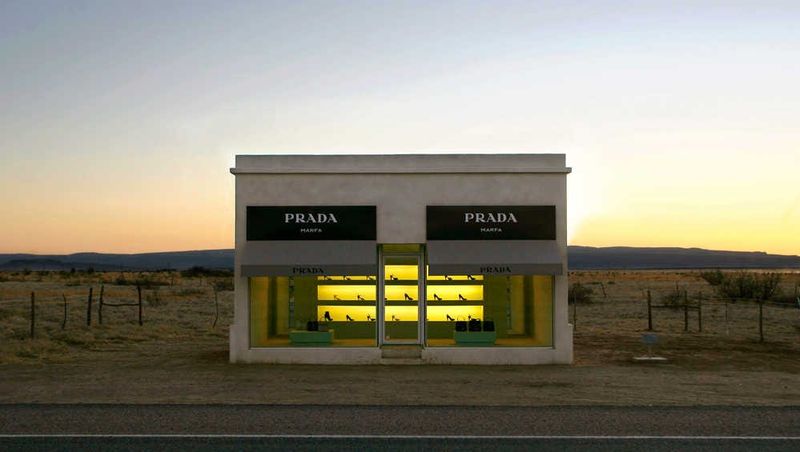
Appearing like a mirage on desolate Highway 90, this permanent installation resembles a high-end boutique dropped into the West Texas desert. Created in 2005 by Scandinavian artists Elmgreen and Dragset, the sealed storefront contains actual Prada merchandise from the fall 2005 collection.
Despite its remote location 26 miles from Marfa (population 1,800), this fake store attracts fashion enthusiasts and art lovers who brave the journey for the perfect Instagram moment. The stark contrast between luxury consumerism and barren landscape creates a powerful commentary on materialism.
Ironically, this critique of fashion has become a fashion pilgrimage site itself, featured in Beyoncé’s social media and countless style magazines. The building slowly deteriorates by design, symbolizing beauty’s impermanence.
7. The Blue Whale of Catoosa: Oklahoma’s Route 66 Icon
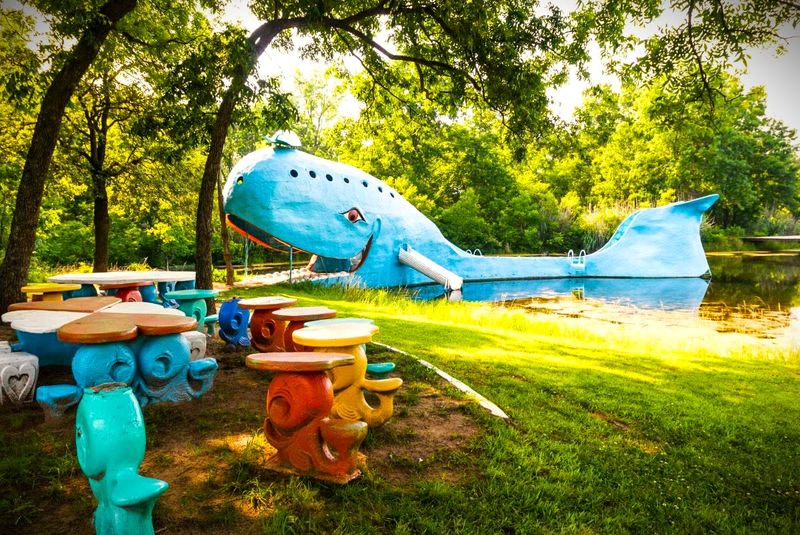
Smiling serenely beside an old swimming hole, this 80-foot cerulean cetacean has delighted Route 66 travelers since 1972. Hugh Davis built the concrete structure as an anniversary gift for his wife, who collected whale figurines, creating a whimsical swimming spot for local children.
Though swimming is no longer permitted, visitors can still climb through the whale’s head, slide down its tail, or picnic in its open mouth. The surrounding pond attracts turtles and waterfowl, creating a peaceful roadside oasis.
After falling into disrepair following Davis’s death, local volunteers restored this beloved landmark to its original blue glory. Today it stands as one of Route 66’s most photographed attractions – a testament to one man’s quirky romantic gesture turned cultural treasure.
8. Carhenge: Nebraska’s Automotive Stonehenge
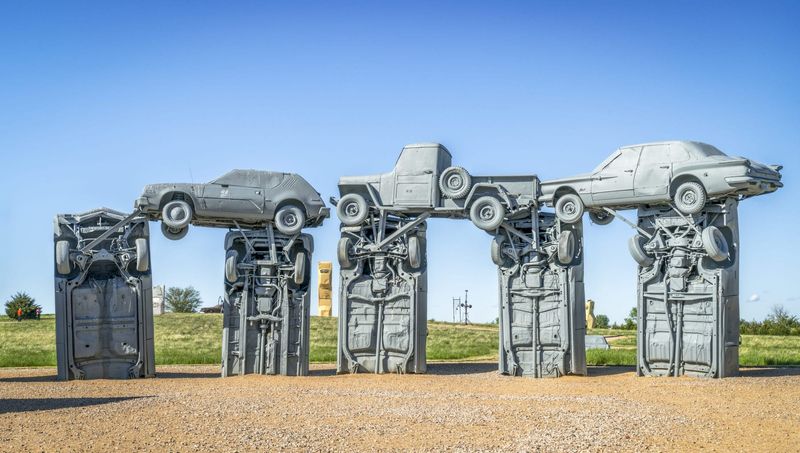
Rising mysteriously from Nebraska’s sandhills, 39 vintage American automobiles form a perfect replica of England’s ancient stone circle. Created in 1987 by Jim Reinders as a memorial to his father, this automotive monument maintains the same proportions and astronomical alignments as its 4,000-year-old inspiration.
The cars – primarily from the 1950s and 60s – stand upright or balance atop others, all painted a uniform gray to mimic weathered stone. Additional car-based sculptures surround the main circle, including the “Ford Seasons” (a parody of Vivaldi).
During the 2017 solar eclipse, thousands gathered at this quirky landmark which fell directly in the path of totality. Located just outside Alliance, Nebraska, Carhenge perfectly embodies American ingenuity and our automotive obsession.
9. Hole N’ The Rock: Utah’s 5,000-Square-Foot Cave Home
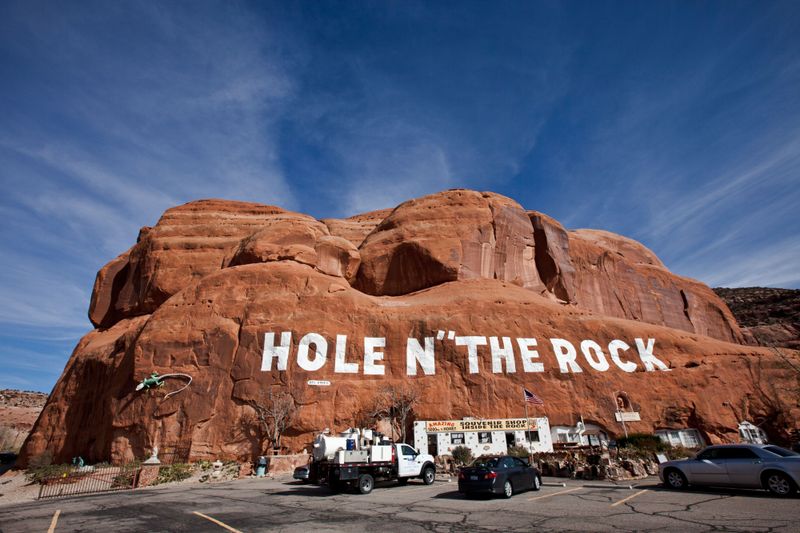
Carved directly into a massive sandstone cliff, this extraordinary 14-room home represents one man’s 20-year obsession with creating the ultimate desert dwelling. Albert Christensen began excavating in the 1940s, eventually removing 50,000 cubic feet of rock using only hand tools and dynamite.
The resulting home features surprisingly elegant rooms, including a 65-foot chimney reaching up through solid stone. Visitors tour the preserved interior filled with original furnishings, Native American artifacts, and Albert’s taxidermy collection.
The property’s exterior boasts quirky sculptures, a petting zoo, and a massive painted sign declaring “HOLE N” THE ROCK” visible from Highway 191. This remarkable monument to human determination demonstrates how one family literally carved their place in the rugged Utah landscape.
10. Enchanted Highway: North Dakota’s Giant Scrap Metal Sculptures
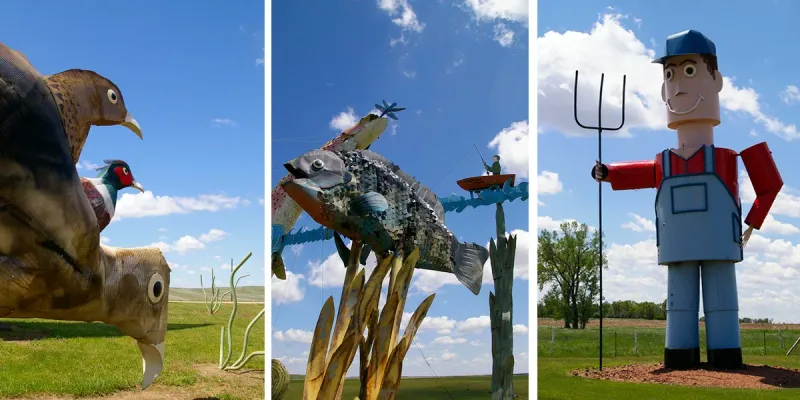
Stretching 32 miles through North Dakota’s rolling prairies, this rural road features seven massive scrap metal sculptures that transform an ordinary drive into an artistic adventure. Retired schoolteacher Gary Greff began creating these towering works in 1990 to prevent his hometown of Regent from fading into obscurity.
Each installation celebrates regional themes: “Geese in Flight” spans 110 feet wide and 70 feet tall, while “Teddy Roosevelt Rides Again” depicts the president on horseback. The “Tin Family” features 45-foot-tall farming parents and their child constructed from oil drums, farm machinery, and metal signs.
Free to visit and spaced roughly four miles apart, these sculptures provide perfect road trip punctuation marks. Greff maintains them all himself, supporting his vision through a gift shop in Regent.

